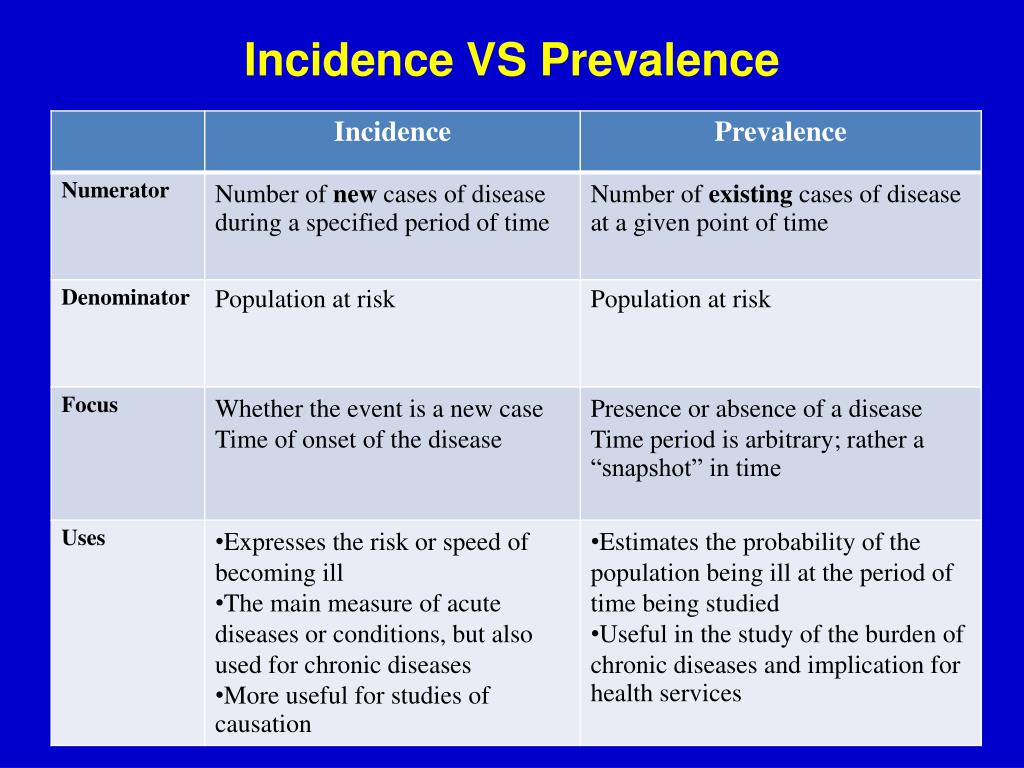While often used interchangeably, incidence and prevalence represent distinct measurements with unique implications for public health research and practice.

Incidence: Capturing the New Cases
Incidence refers to the number of new cases of a disease or health condition that develop in a population during a specific period. It essentially measures the rate at which new cases emerge. Think of it as a measure of risk – the probability of developing a disease over a given timeframe.
- Example: The incidence of lung cancer in a specific city over five years might be 100 new cases per 100,000 people.
Prevalence: Reflecting the Existing Burden
Prevalence, on the other hand, represents the total number of existing cases of a disease or health condition in a population at a specific point in time. It provides a snapshot of the overall burden of the disease within a community.
- Example: The prevalence of diabetes in a particular country might be 10% of the population, indicating that 10 out of every 100 individuals have diabetes at a given moment.
Differentiating Incidence and Prevalence
The key distinction lies in time. Incidence focuses on the development of new cases, while prevalence reflects the overall number of existing cases. Imagine a disease spreading through a population – the incidence will initially spike as new cases emerge, while the prevalence will gradually increase as existing cases accumulate.
Applications in Public Health
Both incidence and prevalence are invaluable tools in public health research and practice:
- Disease Surveillance and Tracking: By monitoring incidence and prevalence trends, public health officials can identify outbreaks, assess the effectiveness of interventions, and allocate resources efficiently.
- Risk Assessment and Prevention: Incidence rates are crucial for evaluating individual and population-level risks. This information can inform targeted prevention strategies and personalize health recommendations.
Resource Allocation: Understanding the prevalence of a disease helps determine the capacity required for healthcare services, supporting planning for hospital beds, treatment facilities, and personnel.
Factors Affecting Incidence and Prevalence
Several factors can influence both incidence and prevalence rates:
- Modifiable Risk Factors: Lifestyle choices, such as smoking, diet, and exercise, can significantly impact the incidence of many diseases.
- Environmental Factors: Exposure to pollution, radiation, or infectious agents can increase the risk of developing certain conditions.
- Access to Healthcare: Timely diagnosis and treatment can affect both incidence and prevalence. Limited access to healthcare can lead to underreporting of cases and higher prevalence rates.
- Aging Population: As populations age, the prevalence of chronic diseases like heart disease, arthritis, and dementia naturally increases.
Technological Advancements: Detecting and diagnosing diseases has become more sophisticated, potentially influencing both incidence and prevalence figures.
Beyond the Numbers: Interpreting with Context
It is essential to remember that incidence and prevalence rates are not stand-alone metrics. They should be interpreted within the broader context of individual risk factors, population demographics, healthcare access, and the specific disease under study. Comparing rates across different populations requires careful consideration of these factors to avoid misleading conclusions.
FAQ
What is the difference between incidence and prevalence?
Incidence measures the rate of new cases developing over time, while prevalence reflects the total number of existing cases at a specific point.
Why are both incidence and prevalence important?
They provide different but complementary perspectives on the burden and dynamics of a health problem, informing disease surveillance, risk assessment, and resource allocation.
Can incidence and prevalence rates be used interchangeably?
No, they measure different aspects of disease occurrence and should not be used as proxies for each other.
How are incidence and prevalence rates calculated?
- Incidence: (Number of new cases) / (Population at risk) * (Time period)
- Prevalence: (Number of existing cases) / (Total population)
Conclusion
Understanding the nuances of incidence and prevalence is paramount for effective public health action. By recognizing their distinct meanings and interpreting them within the broader context of a health problem, we can gain valuable insights into disease burden, risk factors, and the effectiveness of interventions. These measures serve as cornerstones for tailoring public health strategies, allocating resources effectively, and ultimately improving population health outcomes.
Closure
Thus, we hope this article has provided valuable insights into Incidence and prevalence studies. We thank you for taking the time to read this article. See you in our next article!